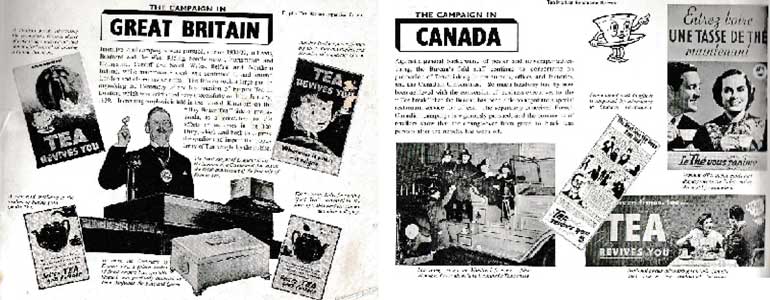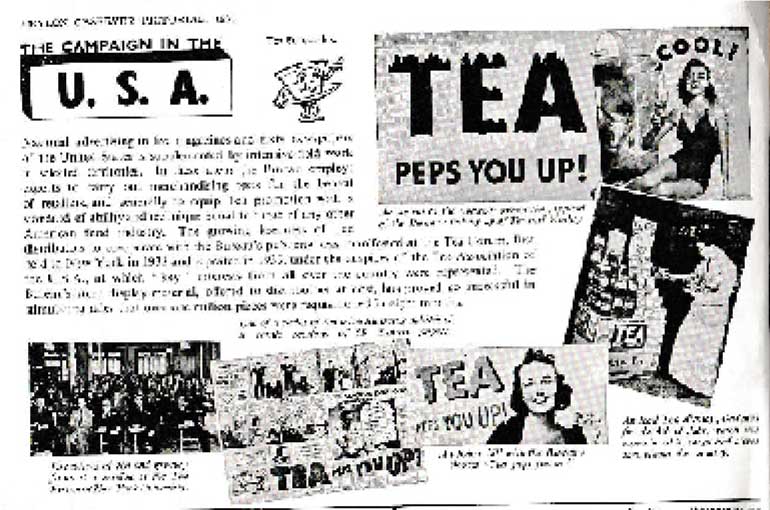Friday Mar 28, 2025
Friday Mar 28, 2025
Saturday, 26 August 2017 00:57 - - {{hitsCtrl.values.hits}}
 While a lot of activities are celebrating the 150th year of Ceylon Tea, I thought it would be interesting to discuss an advertising and promotional campaign of the late 1930s promoting tea.
While a lot of activities are celebrating the 150th year of Ceylon Tea, I thought it would be interesting to discuss an advertising and promotional campaign of the late 1930s promoting tea.
Ceylon was then a Crown Colony in the British Empire. Although the Ceylon Tea Propaganda Board existed, the Empire Tea Market Expansion Bureau handled the promotional work from London. Obviously tea was such as important commodity for the British economy.
Four pages had been devoted in the 1939 edition of the ‘Ceylon Observer Pictorial’ sponsored by the Ceylon Tea Board to carry a synopsis of the global campaign of that year run by the Empire Expansion Bureau. It had a two-fold object of conserving a long-established demand for tea, and motivating more to join the habit of drinking tea.
‘Tea revives you’ was the campaign slogan – an easy to remember, simple, straightforward statement. The advertisements/show-cards were not crowded. There was very little copy and a tea pot was the only picture in most of them. The copy was quite catchy. There were slight variations in some material.
‘Better Tea goes further’ stated one show-card giving the ‘Golden Rules for making Good Tea’. Used for counter and window display, it gave simple instructions of how to make good tea. Warm the tea pot; Put in one teaspoonful for each person and one for the pot; Use freshly drawn, freshly boiled water; Induce for 5 minutes. These were the simple rules. In another show-card on the same theme, the copy read: ‘Better tea means a better intuition – a better flavour – a better cup of tea – and Better Tea goes further’.
The Centenary of Empire Tea was held in London on 10 January 1939 and pictures of the Lord Mayor of London raising the hammer at a Centennial Auction was used for publicity. A golden casket of finest Empire Tea specially blended was presented and “gracefully accepted by Their Majesties the King and Queen” – the parents of Queen Elizabeth II.
In Canada, in addition to poster and newspaper advertising the Bureau’s field staff promoted tea-drinking in restaurants, offices and factories and Canadian universities. Business executives got used to a ‘Tea Break’ and the Bureau staff were able to negotiate a special restaurant service for offices.
One picture released to the newspapers showed tea being served to Montreal firemen.
Travelling propaganda vans took the message to the important centres of native population in South Africa. Films were screened and lecture demonstrations were held in schools. There was concentration on rural Dutch communities where the traditional drink was coffee. A calendar for 1939 was distributed with a picture of the Royal Family alongside facts about tea.

In Australia the campaign was extended from areas outside main urban areas like Sydney, Melbourne and Newcastle. Promotional work was done to maintain a high standard of tea service in restaurants, and to stimulate interest in tea promotion in hotels, milk bars and coffee shops. These were backed by radio and newspaper advertising. The Education Department was persuaded to adopt lessons and films on tea in what was then, new Visual Education schemes.
The campaign in the USA used the slogan ‘Tea peps you up!’ to appeal to the younger generation and also link up tea and vitality. There was national advertising in five magazines and sixty newspapers supplemented by intensive field work in selected territories. The Bureau employed experts to carry out merchandising tests for the benefit of retailers and to equip tea promotion with a high standard to match any other American food industry.
The success of a Tea Forum held in 1938 prompted the Bureau to hold another in 1939 in collaboration with the Tea Association of the USA. The distributor participation and enthusiasm was encouraging.
The campaign also covered Europe with the accent on Holland, Belgium and Sweden. A wide field was covered including schools, universities, clubs, traders’ organisations, sports meetings and the like. Demonstrations held using propaganda vans drew large crowds.
 The campaign in Egypt was strengthened by the government policy of suppressing adulterated tea. A chemist from the Government Laboratories was kept busy checking samples of tea sent in by travelling inspectors. In summer, a concentrated Iced Tea campaign was maintained in key cities like Cairo, Alexandria and Port Said.
The campaign in Egypt was strengthened by the government policy of suppressing adulterated tea. A chemist from the Government Laboratories was kept busy checking samples of tea sent in by travelling inspectors. In summer, a concentrated Iced Tea campaign was maintained in key cities like Cairo, Alexandria and Port Said.
It was announced that a complete collection of the publicity materials was exhibited at the Ceylon Tea Propaganda Board offices in the Chamber of Commerce building in Colombo.